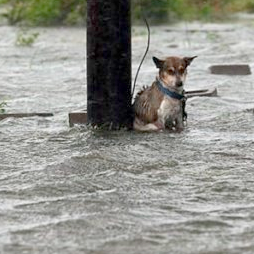Emergencies come in many forms, and they may require anything from a brief absence from your home to permanent evacuation. Each type of disaster requires different measures to keep your pets safe, so the best thing you can do for yourself and your pets is to be prepared. Here are simple steps you can follow now to make sure you’re ready before the next disaster strikes:
Step 1: Prepare Emergency Supplies and
Traveling Kits
If you must evacuate your home in a crisis, plan for the worst-case scenario. Even if you think you may be gone for only a day, assume that you may not be allowed to return for several weeks. When recommendations for evacuation have been announced, follow the instructions of local and state officials. To minimize evacuation time, take these simple steps:
- Make sure all pets wear collars and tags with up-to-date identification information. Your pet’s ID tag should contain his name, telephone number and any urgent medical needs. Be sure to also write your pet’s name, your name and contact information on your pet’s carrier.
- The ASPCA recommends microchipping your pet as a more permanent form of identification. A microchip is implanted under the skin in the animal’s shoulder area, and can be read by a scanner at most animal shelters.
- Always bring pets indoors at the first sign or warning of a storm or disaster. Pets can become disoriented and wander away from home in a crisis.
- Store an emergency kit and leashes as close to an exit as possible. Make sure that everyone in the family knows where it is, and that it clearly labeled and easy to carry. Items to consider keeping in or near your “Evac-Pack” include:
- Pet first-aid kit and guide book (ask your vet what to include)
- 3-7 days’ worth of canned (pop-top) or dry food (be sure to rotate every two months)
- Disposable litter trays (aluminum roasting pans are perfect)
- Litter or paper towels
- Liquid dish soap and disinfectant
- Disposable garbage bags for clean-up
- Pet feeding dishes and water bowls
- Extra collar or harness as well as an extra leash
- Photocopies and/or USB drive of medical records and a waterproof container with a two-week supply of any medicine your pet requires (Remember, food and medications need to be rotated out of your emergency kit—otherwise they may go bad or become out-of-date)
- At least seven days’ worth of bottled water for each person and pet (store in a cool, dry place and replace every two months)
- A traveling bag, crate or sturdy carrier, ideally one for each pet
- Flashlight
- Blanket
- Recent photos of your pets (in case you are separated and need to make “Lost” posters)
- Especially for cats: Pillowcase, toys, scoop-able litter
- Especially for dogs: Extra leash, toys and chew toys, a week’s worth of cage liner

You should also have an emergency kit for the human members of the family. Items to include in your kit: Batteries, duct tape, flashlight, radio, multi-tool, tarp, rope, permanent marker, spray paint, baby wipes, protective clothing and footwear, extra cash, rescue whistle, important phone numbers, extra medication and copies of medical and insurance information.
Step 2. If you must evacuate, know where to go
Arrange a safe haven for your pets in the event of evacuation. DO NOT LEAVE YOUR PETS BEHIND. Remember, if it isn’t safe for you, it isn’t safe for your pets. They may become trapped or escape and be exposed to numerous life-threatening hazards. Note that not all shelters accept pets, so it is imperative that you have determined where you will bring your pets ahead of time:
- Contact your veterinarian for a list of preferred boarding kennels and facilities.
- Ask your local animal shelter if they provide emergency shelter or foster care for pets.
- Identify hotels or motels outside of your immediate area that accept pets.
- Ask friends and relatives outside your immediate area if they would be willing to take in your pet.
Other Considerations
Geographic Considerations: If you live in an area that is prone to certain natural disasters, such as tornadoes, earthquakes or floods, you should plan accordingly.
- Determine well in advance which rooms offer safe havens. These rooms should be clear or hazards such as windows, flying debris, etc.
- Choose easy-to-clean areas such as utility rooms, bathrooms and basements as safe zones
- Access to a supply of fresh water is particularly important. In areas that may lose electricity, fill up bathtubs and sinks ahead of time to ensure that you have access to water during a power outage or other crises.
- In the event of flooding, go to the highest location in your home, or a room that has access to counters or high shelves where your animals can take shelter.
For more information visit: ASPCA – http://www.aspca.org